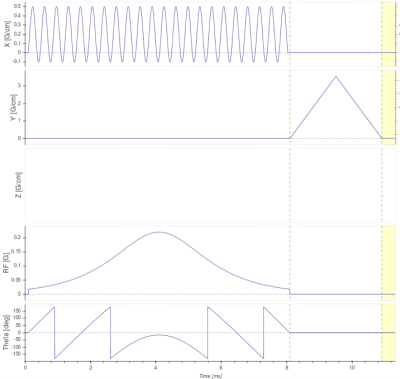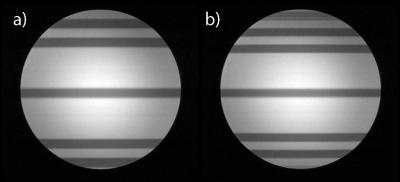0605
Multiband Adiabatic Inversion Using Multiphoton Excitation1Electrical Engineering and Computer Sciences, University of California, Berkeley, Berkeley, CA, United States, 2Helen Wills Neuroscience Institute, University of California, Berkeley, Berkeley, CA, United States
Synopsis
We present a technique for power-efficient multiband adiabatic inversion using the concept of multiphoton excitation. In this case, multiphoton excitation occurs with one photon from our traditional RF source and one or more photons from oscillating gradients. By a proper choice of oscillating gradients, we can meet multiphoton resonance conditions at multiple spatial locations, and thus achieve multiband multiphoton adiabatic inversions. Only a slightly scaled standard adiabatic pulse is needed on the traditional RF side. We demonstrate the technique with simulations, phantom and in vivo experiments on a 3T scanner.
Introduction
Multiband RF pulses typically consist of several independent single-band RF pulses under the influence of a slice selective gradient. The utilization of multiple RF pulses leads to high peak and overall power when many bands are desired. For adiabatic RF pulses, the creation of multiple bands simultaneously is somewhat trickier due to the nonlinearity involved. Nonetheless, pulse summation still works, if certain power level constraints are met1. More recently, it has been shown that multiband adiabatic inversion can be produced by periodically switching the gradients and RF on and off2. This greatly reduces the power required but lengthens the pulse duration. Here, we present another technique for multiband adiabatic inversion using the concept of multiphoton excitation3. By oscillating the gradients, we can meet multiphoton resonance conditions at multiple locations, and thus achieve multiband multiphoton adiabatic inversions. Only a single adiabatic pulse is needed on the RF side.Methods
Multiphoton excitation occurs whenever we satisfy the multiphoton resonance condition where integer multiples of multiple RF frequencies sum to equal the Larmor frequency and angular momentum is conserved. One form of multiphoton excitation in MRI occurs with a single photon polarized in the xy-plane ($$$B_{1,xy}$$$ with frequency $$$\omega_{xy}$$$) and one or more photons polarized along the z-axis ($$$B_{1,z}$$$ with frequency $$$\omega_{z}$$$). Since the magnetic fields of gradient coils in MRI are oriented along the z-axis, by oscillating gradients, we are able to provide z-axis photons for multiphoton resonances. As described previously3, the effective angular nutation frequency corresponding to an effective multiphoton amplitude for a single xy-photon and single z-frequency is$$ \omega_{nut}=\gamma\ B_{1,xy}J_n\left(\frac{\gamma B_{1,z}}{\omega_z}\right) \hspace{2em} [1] $$
$$$J_n$$$ represents the Bessel function of the first kind of order $$$n$$$. $$$n$$$ represents the number of z-axis photons in the resonance. Note that $$$n$$$ can be positive or negative. For multiple z-frequencies, a Bessel function is multiplied for each frequency. For example, for two z-frequencies, we have resonances whenever
$$ \omega_{xy}=\gamma\ B_0+n\omega_{z1}+m\omega_{z2} \hspace{2em} [2] $$
and for each $$$n$$$ and $$$m$$$, the corresponding angular nutation frequency is given by
$$ \omega_{nut}=\gamma\ B_{1,xy}J_n\left(\frac{\gamma B_{1,z1}}{\omega_{z1}}\right)J_m\left(\frac{\gamma B_{1,z2}}{\omega_{z2}}\right) \hspace{2em} [3] $$
Therefore, if a constant DC gradient superimposes an oscillating AC gradient, given a frequency-centered $$$B_{1,xy}$$$, multiphoton resonances occur at locations where the local Larmor frequency (shifted by the DC gradient) and the frequency of the AC gradient satisfy Eq. [2]. Furthermore, in the case of a single gradient frequency, the argument to the Bessel function will be the ratio of the AC gradient strength to the DC gradient strength multiplied by the order of the Bessel function. Thus, if we choose the AC gradient strength to be 1.5 times the DC gradient strength, we will have excitation bands corresponding to an unscaled $$$B_{1,xy}$$$ at the center for the single-photon resonance, plus/minus $$$J_1(1.5)$$$ scaling for two photon resonances, plus/minus $$$J_2(3.0)$$$ scaling for three photon resonances, etc., until we are outside of the field of view. Note that this example provides a good choice for the AC gradient strength, as the Bessel functions are nearly maximized. Although we illustrate adiabatic excitation here, this scheme works for both adiabatic and non-adiabatic excitation.
Results
The proposed multiphoton multiband adiabatic inversion pulse was implemented in an inversion-recovery-prepared 2D fast spin echo sequence on a GE 3T MR750w scanner. The pulse sequence was coded using KSFoundation Epic4. To view the multiband inversion profiles, the inversion-pulse gradients were along an axis perpendicular to the fast spin echo imaging plane. Experiments were conducted on a spherical phantom and a human volunteer. Fig. 1 shows example pulse waveforms, Fig. 2 shows simulated resulting z-magnetization for the example pulses in Fig. 1 and others, Fig. 3 shows multiband inversion on a spherical phantom with various parameters, Fig. 4 shows an example of unevenly spaced inversion bands with multiple gradient frequencies, and Fig. 5 shows inversion bands over a human brain in vivo.Discussion
When producing multiple inversion bands, the use of multiphoton resonances increases RF efficiency as the same RF pulse produces excitation in each band. The use of adiabatic pulses provides immunity against different effective pulse amplitudes of each multiphoton resonance, resulting in equal or comparable inversion. The RF pulse amplitude, however, needs to be high enough such that all the multiphoton resonances of interest fulfill the adiabatic condition. This leads to a slight increase in the RF pulse amplitude from a single-band adiabatic pulse as the Bessel functions are always less than or equal to 1. If some ripple is acceptable in the extra inversion bands, the RF pulse can be exactly the same as that of a standard single-band adiabatic pulse.Conclusion
We have demonstrated power-efficient multiband adiabatic inversion pulses using the concept of multiphoton resonances. Such pulses may be useful for simultaneous multislice imaging techniques5,6 or other more exotic pulse sequences that make use of adiabatic pulses7. This is one example demonstrating how a multiphoton interpretation of excitation can open new avenues for novel pulse design.Acknowledgements
No acknowledgement found.References
1. Goelman G, Leigh JS. Multiband Adiabatic Inversion Pulses. Journal of Magnetic Resonance, Series A. 1993;101(2):136-146. doi:10.1006/jmra.1993.1023
2. Koopmans PJ, Boyacioğlu R, Barth M, Norris DG. Simultaneous multislice inversion contrast imaging using power independent of the number of slices (PINS) and delays alternating with nutation for tailored excitation (DANTE) radio frequency pulses. Magnetic Resonance in Medicine. 2013;69(6):1670-1676. doi:10.1002/mrm.24402
3. Han V, Liu C. Multiphoton Magnetic Resonance Imaging. Submitted, Under Review.
4. Neuro MR physics group, Karolinska University Hospital. KS Foundation – A platform for simpler EPIC programming. http://ksfoundationepic.org/index.html. Accessed November 2, 2019.
5. Larkman DJ, Hajnal JV, Herlihy AH, Coutts GA, Young IR, Ehnholm G. Use of multicoil arrays for separation of signal from multiple slices simultaneously excited. J Magn Reson Imaging. 2001;13(2):313-317.
6. Setsompop K, Gagoski BA, Polimeni JR, Witzel T, Wedeen VJ, Wald LL. Blipped-controlled aliasing in parallel imaging for simultaneous multislice echo planar imaging with reduced g-factor penalty. Magnetic Resonance in Medicine. 2012;67(5):1210-1224. doi:10.1002/mrm.23097
7. Zhang Z, Saginer A, Frydman L. Single-scan magnetic resonance imaging with exceptional resilience to field heterogeneities. Magn Reson Med. 2017;77(2):623-634. doi:10.1002/mrm.26145
Figures




